Tiny COM modules get WiFi, OpenGL options
Apr 7, 2009 — by Eric Brown — from the LinuxDevices Archive — 30 views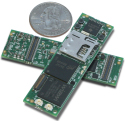 Gumstix launched new versions of its “Overo” gumstick-sized, open-source Linux COM modules. Like the original Overo Earth, the Overo Air (WiFi) module incorporates an ARM Cortex-A8-based Texas Instruments OMAP3503 SoC, while the Overo Water (OpenGL graphics) and Overo Fire (OpenGL/WiFi) modules move up to the OMAP3530.
Gumstix launched new versions of its “Overo” gumstick-sized, open-source Linux COM modules. Like the original Overo Earth, the Overo Air (WiFi) module incorporates an ARM Cortex-A8-based Texas Instruments OMAP3503 SoC, while the Overo Water (OpenGL graphics) and Overo Fire (OpenGL/WiFi) modules move up to the OMAP3530.
(Click for larger view of the Overo Air COM)
Targeted at production runs of between 1,000 to 50,000, the new Overo modules share the same 0.7 x 2.3 x 0.2-inch (17 x 58 x 4.2mm) dimensions as the Overo Earth, which shipped in October. Gumstix is offering the modules with the previously available Summit expansion board, as well as two new boards: the touchscreen-targeted Palo43 board and the Ethernet-enabled Tobi board (see farther below).
All four Overo modules are 40 percent smaller than the earlier 3.2 x 0.8 x 3.2-inch Gumstix Verdex modules, which were based on the Marvell PXA270 (aka “Bulverde”) processor. The Overo modules instead use the more powerful Texas Instruments (TI) OMAP35xx system-on-chips (SoCs). Although clocked similarly at 600MHz, they offer faster performance thanks to their ARM Cortex-A8 superscalar core, which enables instruction-level parallelism within a single processor.
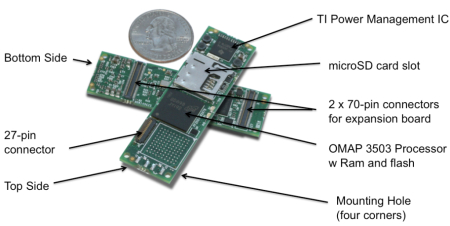
Overo Earth
(Click to enlarge)
Whereas the OMAP3503 used by the Overo Earth and Overo Air modules is the low-end version of TI's four OMAP35xx processors, the new Water and Fire modules use the high-end, media-focused OMAP3530. The 3530 adds a C64X+ DSP (digital signal processor) and video accelerator, as well as OpenGL ES 2.0 graphics acceleration via the PowerVR SGX graphics engine licensed by Imagination Technologies. The Overo modules are all pin-compatible, says Gumstix.
Specific differentiating features of the three new modules include:
- Overo Air COM — Based on the OMAP3503, the Air COM offers WiFi (802.11b/g) and Bluetooth capabilities via an onboard W2CBW003 module from Wi2Wi. The module supports simultaneous WiFi and Bluetooth operation, says Wi2Wi.
- Overo Water COM — Using the more media-capable OMAP3530, the Water COM provides a TI TMS320C64x+ DSP and OpenGL ES graphics “to enhance applications designs with such features as a smart user interfaces and photo-realistic graphics,” says Gumstix.
- Overo Fire COM — This top-of-the-line module combines the Overo Air's Wi2Wi module with the same OMAP3530-based multimedia enhancements of the Overo Water.
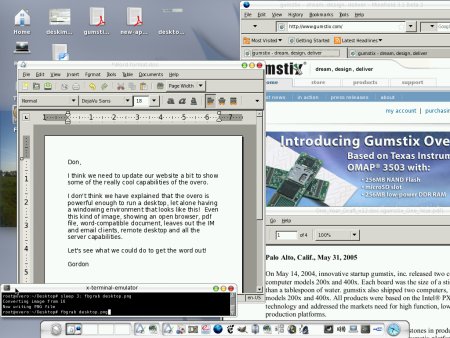
A windowing UI driven by the Overo
(Click to enlarge)
All four Overo modules are equipped with 256MB of low-power DDR RAM and 256MB of NAND flash, says Gumstix. The RAM and Flash are packaged with the TI processor in a multi-chip package (MCP) supplied by Micron. In addition, there is an on-board microSD adapter, a 24-pin flex ribbon connector for camera control signals, and dual 70-pin AVX 5602-14 connectors for various functional options in expansion board design, says the company. Power consumption is claimed to be less than a single Watt.
Features offered by the Overo boards include:
- Processor — OMAP3503 (Earth and Air) or OMAP3530 (Water and Fire)
- Memory — 256MB of low-power DDR RAM
- Flash — 256MB of NAND flash
- Flash expansion — microSD adapter
- Display — 24-bit LCD signals; OpenGL ES 2.0 and video acceleration (Water and Fire only)
- WiFi/Bluetooth — 802.11b/g and Bluetooth (Air and Fire only)
- I/O:
- 2 x peripheral interrupts, reset, wake, and power-on
- I2C signaling, 6 x PWM lines, UART, IR_UART port
- Headset out lines, power, ground, backup, Pseudo-differential mic
- A/D (6 x 10 bits), 1-wire signaling
- USB OTG signals (Host or Client mode)
- EHCI (USB Host)
- Address-bus chip selects and control lines, address lines 1:10
- Data lines 0:15, SPI bus with 2 selects, IRQ lines
- 8-bit MMC signals
- Camera input (12 bit)
- Power — 1.8 Watt supply with 3.3V to 4.2V voltage; 250mA @ 4v power draw; TPS65950 power management IC
- Dimensions — 0.7 x 2.3 x 0.2 inches (17 x 58 x 4.2mm)
- Connectors — 2 x 70-pin AVX 5602-14 connectors; 24-pin flex ribbon connector for camera signals
- Mounting — 4 x #0 mounting holes, one on each corner
- Operating temperature — 32 to 185 deg. F (0 to 85 deg. C)
- Operating system — Linux 2.6.27 or higher
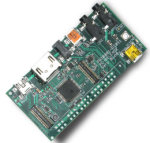 Summit expansion board (Click to enlarge) |
Expansion boards
The Overo COM modules are offered with a choice of three expansion boards. They all offer USB connectivity, including mini-AB (with OTG), mini-B (with USB Host), and a USB console. Other connectivity, provided via a 40-pin unpopulated standard header, include dual two-wire serial ports, a single 1-wire port, 6 PWM lines, an I2C port, an SPI bus, and six A/D input lines and processor control signals. Multiple signals are available on 0.100-inch through-holes at 1.8V logic, says the company. The boards each have 4V to 5.5V power input, and offer dual 70-pin AVX connectors and four mounting holes to match up with the Overo COM modules.
Differentiating details for the boards include:
- Summit — Previously available with the Overo Earth, the Summit board offers DVI-D (HDMI) and audio in/out, and measures 3.1 x 1.5 inches (80 x 39mm).
- Palo43 — Claimed to be “LCD-ready for a 4.3-inch Samsung touchscreen,” the Palo43 (see below) provides a touchscreen controller with 16 bits-per-pixel display capability. It measures 4.7 x 2.6 inches (118.3 x 67.25mm).
- Tobi — Featuring a 10/100 Ethernet port, the Tobi (pictured below) also provides a DVI-D (HDMI) port as well as audio in/out. It measures 4.1 x 1.6 inches (105 x 40mm).
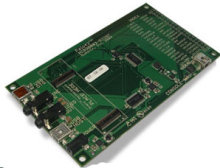
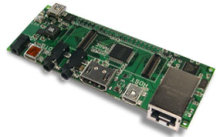
Palo43 (left) and Tobi expansion boards
(Click on either to enlarge)
Stated Jason Kridner, Open Platforms Technologist/Evangelist, Texas Instruments, “We are excited to see Gumstix enhance their Overo series with the addition of these OMAP3530-based COM modules with 3D graphics acceleration, programmable DSP, wireless communications and network expansion options.”
Availability
For orders of 1,000 units or more, Overo COM modules are available now, and can be configured starting at $98.50, says Gumstix. Standard pricing is $150 (Overo Earth), $170 (Water), $200 (Air), and $220 (Fire). The Palo43 expansion board is priced at $52, the Summit board runs $50, and the Tobi board is $61.
More information on the Overo COM modules may be found here, and the Gumstix purchasing page is here. Documentation for the Overo boards is available at the Gumstix Developer's website, here, and schematics may be found here.
This article was originally published on LinuxDevices.com and has been donated to the open source community by QuinStreet Inc. Please visit LinuxToday.com for up-to-date news and articles about Linux and open source.